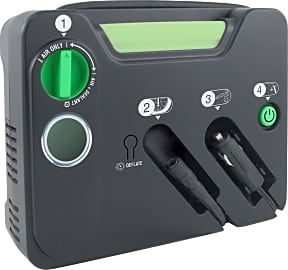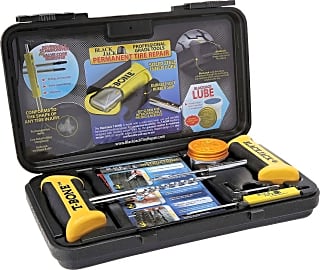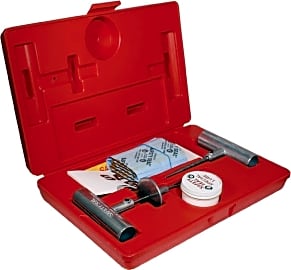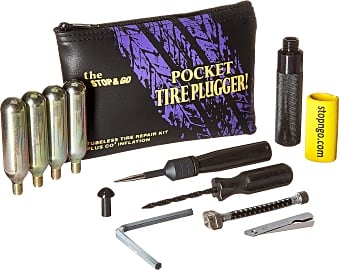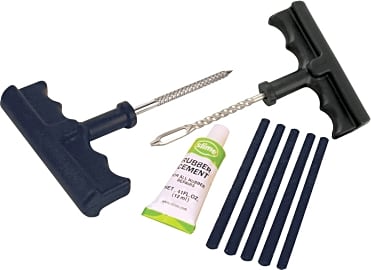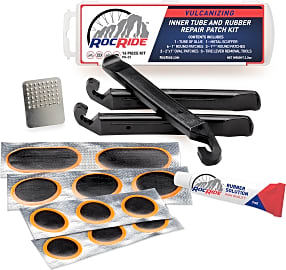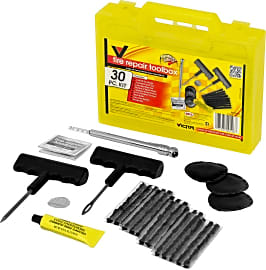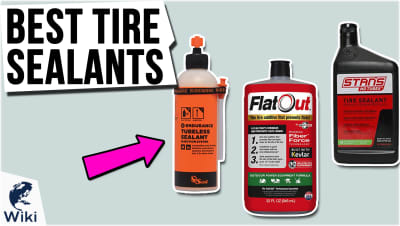The 9 Best Tire Repair Kits

This wiki has been updated 38 times since it was first published in January of 2016. Worst case scenario? You're on your way to an important job interview when you get a flat tire, and you don't have a spare. With one of these tire repair kits, you can get back on the road reasonably quickly. We have included options that temporarily plug a leak so you can get to a shop, some that provide a more permanent fix, and some for motorcycles and bicycles, too. When users buy our independently chosen editorial selections, we may earn commissions to help fund the Wiki.
Editor's Notes
July 09, 2021:
The only change made this time around was upgrading to the Slime 50123 from the 50063, which is no longer in production. The newer model is about as straightforward as they get, and can help mitigate disaster on the road. The Boulder Tools BT4001 remains the top professional-grade kit for use at home or in a shop.
Keep in mind, though, that if you do opt to use an emergency filler like Slime or Fix-a-Flat, it can throw the tire's balance off in the long term and can interfere with integrated tire pressure sensors. In those instances, you'll have to balance the convenience of repairing it yourself and potentially damaging the tire, vs. the safety of calling a tow truck or roadside assistance.
February 26, 2020:
Removed the Fix-a-Flat Ultimate because of availability issues. Added the Blackjack KT-340 and the Fix-A-Flat S60430.
There is a general divide between permanent and emergency style repair kits. Permanent repair kits like the Boulder Tools BT4001 and the Blackjack KT-340 usually include a reamer, a loop tool, and plugs. These plugs are designed to bind to the surrounding rubber and permanently seal holes, when its done correctly. The trade-off is that while many manufacturers proudly claim that these kits can be used with the tire still on the car, you'll usually find out that you have a flat when there is very little air left in the tire. Therefore, while it is true that you can plug the hole with the tire still on the car, if you don't have a compressor, you'll still have to take the tire off and drive it to a compressor.
True road-side emergency repair kits like the Fix-A-Flat S60430 and the Slime 50063 can similarly be used with the tire still on the car and will inflate the inner lining and give you enough time to get to a tire shop for permanent repairs.
A Brief History Of Tires
And while these new tires may never go flat, one thing's for certain: they'll surely find some other way to ruin your day when it's raining.
If cartoons have taught us anything, it's that the first tires were square blocks attached to primitive wheelbarrows that were carted around by cavemen. That's probably not accurate, and it's likely that we shouldn't get our information about history from cartoons.
In actuality, the first tires were strips of leather that were wrapped around wooden wheels on carts and wagons to protect them on rocky and uneven terrain.
Rubber pneumatic tires and steel wheels would eventually take their place, with the first patent being issued in 1847 to the Scottish inventor Robert William Thomson. That prototype never went into production, however. Forty years later, it would be another Scotsman, John Boyd Dunlop, who would actually follow through with a design for a pneumatic rubber tire intended for cyclists.
Dunlop was able to utilize the newfangled vulcanization process that had been invented by the American Charles Goodyear a few decades earlier. This process involved combining the raw rubber with sulfur, leading to a product that was durable, shock-absorbent, and resistant to cuts and abrasions. By combining vulcanized rubber with a pneumatic design, Dunlop was finally able to create a product worthy of riding around on.
For the first half of the 20th century, tires contained an inner tube filled with compressed air, housed inside a heavy-duty rubber shell. They were then reinforced with layers known as "plies," and the whole thing was called a "bias ply" tire.
In 1946, Michelin created steel-belt radial tires, which were longer-lasting, more durable, and offered reduced resistance, enabling advances in fuel efficiency.
The future of tires will likely involve "smart" technology, which would communicate with the car to customize the driving experience for the road conditions at the time. They'll also likely ditch air as well, and will instead be made entirely of renewable, recyclable plastics, or they may even ditch their traditional shape in favor of 360° rubber balls.
And while these new tires may never go flat, one thing's for certain: they'll surely find some other way to ruin your day when it's raining.
How To Repair A Tire
There's no more sickening feeling than when you're flying down the freeway, only to hear that ominous pop and suddenly feel your car lurch to the side — and that's before you have to shell out to replace the flat.
The good news is that, in many cases, you can cheaply and easily repair the tire yourself, without getting as gouged as the rubber on your wheel.
The first thing you need to do is locate the source of the puncture. Oftentimes, it will be easy to spot — it's the part of the tire with the nail sticking out of it. Other times, whatever caused the leak isn't still in the tire, and you may have difficulty finding the hole's location.
Then, shove the entire plug into the hole until there's only about a half-inch of the sticky stuff left outside, then pull the tool straight out.
If it's not immediately obvious where the leak is, fill the tire with air and rub soapy water over it. Whenever the soapy mixture reaches the hole, it will start to bubble up as the air escapes. Mark the spot with a grease pencil.
Before we go any further, it's important to note that you should never patch a hole on the sidewall. The sides of your tires are under different pressure than the treads, and patching them up can lead to a potentially-deadly blowout. If it's on the sidewall, you'll likely have to suck it up and replace the whole thing. Also, if the hole is more than about 1/4-inch in size, repair kits won't be much help.
Once you have the spot marked — and the offending piece of metal removed, if applicable — then it's time to start patching. Most kits have a tool that looks like a round file, which you should use to clean out the hole. Shove it in there and move it up and down roughly a few times.
Next, grab the sticky stuff in your kit and thread it through the tool that looks like a giant needle. Keep it centered in the eye of the needle, so that there's an equal amount sticking out of each side of the tool. Then, shove the entire plug into the hole until there's only about a half-inch of the sticky stuff left outside, then pull the tool straight out.
The plug should stay in the hole, like...well...a plug. You can trim or file off the excess, then fill the tire as needed. Voilà — you've just repaired your first tire! Congratulations!
Now top off the tank, and would it kill you to clean off the windshield?
Tips For Prolonging The Life Of Your Tires
Tires are something you never give much thought to — until you see how much it costs to replace them. With that in mind, here are a few tips for getting more value for your money from your tires.
Tires are something you never give much thought to — until you see how much it costs to replace them.
The most important thing is to follow all manufacturer recommendations, especially when it comes to pressure and maintenance. Get your tires checked and rotated every 6-8,000 miles to ensure that they're all evenly worn. While you're at it, have them check your alignment, too.
Be careful while you're driving, as well. While it is satisfying to peel out at every single stoplight, it will cost you over time, as that really wears on your treads. Likewise, take it easy on rough or poorly-maintained roads, and of course be on the lookout for hazards while you drive.
Drivers who live in warm climates should pay special attention to their wheels, as hot weather can increase the effects of aging and impact tire pressure. Check your tread depth regularly, and don't be afraid to replace them as soon as it becomes necessary.
After all, tires are expensive — but they're not worth your life.


